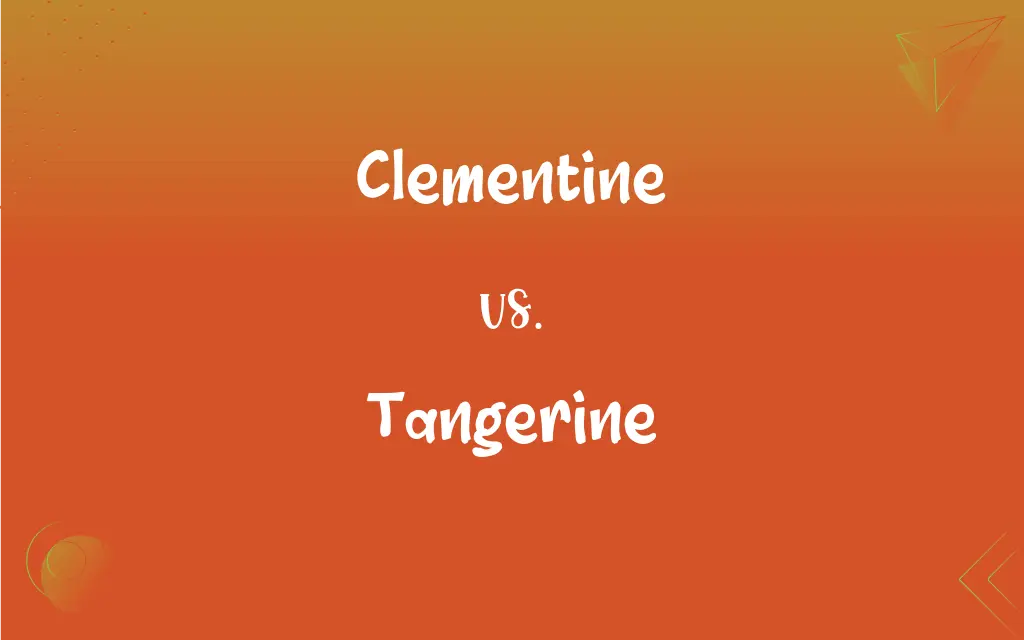Clementine vs. Tangerine: What's the Difference?
Edited by Aimie Carlson || By Harlon Moss || Updated on October 24, 2023
Clementine is a seedless mandarin hybrid, while tangerine is a larger, orange-colored citrus fruit with seeds.

Key Differences
Clementine and tangerine are both types of citrus fruits, belonging to the mandarin family. While clementines are often known for their seedless nature and easy-to-peel skin, tangerines are recognized for their distinctive orange color and seeds.
Both clementine and tangerine are popular fruits, especially in colder months when they are most in season. The clementine is typically smaller, sweeter, and almost always seedless. In contrast, tangerines are slightly larger, have a stronger citrus flavor, and generally contain seeds.
The outer skin of the clementine is smoother and shinier, and it can be peeled off effortlessly, making it a favorite snack for many. Tangerines, on the other hand, might require a bit more effort to peel, and their skin has a rougher texture.
In culinary uses, both fruits are versatile. However, clementines, given their sweet flavor and lack of seeds, are often preferred for fresh consumption or in fruit salads. Tangerines, with their bold flavor, are frequently used in cooking, baking, and beverages for a strong citrus punch.
While both fruits are rich in vitamins, especially vitamin C, their nutritional profiles differ slightly. It's crucial to understand that while they may appear similar, clementines and tangerines have distinct characteristics that cater to different preferences and uses.
ADVERTISEMENT
Comparison Chart
Seed Presence
Typically seedless.
Contains seeds.
Size
Smaller.
Larger.
Flavor
Sweeter.
Stronger citrus flavor.
Skin Texture and Ease of Peeling
Smoother, easier to peel.
Rougher, slightly tougher to peel.
Culinary Uses
Preferred for fresh consumption and fruit salads.
Used in cooking, baking, and beverages.
ADVERTISEMENT
Clementine and Tangerine Definitions
Clementine
A small, seedless citrus fruit.
She packed a clementine for her child's snack.
Tangerine
A fruit with a rough outer skin.
She struggled a bit while peeling the tangerine.
Clementine
A hybrid variety of mandarin.
The clementine tree in the backyard bore plenty of fruits this season.
Tangerine
An orange-colored citrus fruit with seeds.
He added fresh tangerine juice to the cocktail.
Clementine
A popular winter fruit.
Clementines are often found in holiday fruit baskets.
Tangerine
Rich in vitamins and often used in culinary dishes.
The salad had a refreshing tangerine dressing.
Clementine
Known for its sweet taste and easy-to-peel skin.
The dessert was topped with clementine segments.
Tangerine
A variety of mandarin orange.
Tangerine trees lined the orchard.
Clementine
A member of the orange family, with a shiny outer surface.
The clementine's shiny skin caught her eye in the fruit aisle.
Tangerine
Known for its strong citrus flavor.
The cake had a hint of tangerine zest.
Clementine
A deep red-orange, often seedless mandarin orange.
Tangerine
A widely cultivated variety of mandarin orange having deep red-orange fruit with easily separated segments.
Clementine
A type of small, sweet orange, the result of a cross between a tangerine and Seville orange.
Clementine
Of or pertaining to Clement, esp. to St. Clement of Rome and the spurious homilies attributed to him, or to Pope Clement V. and his compilations of canon law.
Clementine
A variety of mandarin orange that is grown around the Mediterranean and in South Africa
Clementine
A mandarin orange of a deep reddish orange color and few seeds
FAQs
Which is sweeter, clementine or tangerine?
Clementines are generally sweeter than tangerines.
Are both clementines and tangerines types of oranges?
They're both mandarins, which are part of the orange family but distinct from typical oranges.
Do tangerines always have seeds?
While tangerines typically contain seeds, seedless varieties also exist.
Can both fruits be juiced?
Yes, both clementines and tangerines can be juiced, but tangerines may require seed removal.
Why are clementines often preferred in fruit salads?
Clementines are preferred due to their sweetness and lack of seeds.
Why are clementines popular as snacks?
Clementines are popular because they're seedless, sweet, and easy to peel.
Which has a rougher skin?
Tangerines have a rougher skin compared to clementines.
Can you interchange clementines and tangerines in recipes?
Yes, but there may be slight flavor and texture differences.
Are clementines always seedless?
Clementines are typically seedless, but occasionally one might contain seeds.
When are these fruits in season?
Both fruits are typically in season during the colder months.
Are there color variations in tangerines?
Yes, tangerines can range from reddish-orange to lighter orange.
Can you eat the seeds of tangerines?
While tangerine seeds are edible, they're often removed due to their bitter taste.
Which fruit has a stronger citrus flavor?
Tangerines have a stronger citrus flavor compared to clementines.
Do both fruits provide vitamin C?
Yes, both clementines and tangerines are rich in vitamin C.
How should these fruits be stored?
Both can be stored at room temperature or refrigerated to prolong freshness.
Can both fruits be used for zesting?
Yes, the zest of both clementines and tangerines can be used in recipes.
Which fruit peels more easily?
Clementines generally peel more easily than tangerines.
How are the nutritional profiles different?
Both are nutrient-rich, but they might have slight variations in sugar, fiber, and vitamin content.
Can these fruits be eaten daily?
Yes, clementines and tangerines can be a healthy addition to a daily diet.
Which fruit is larger?
Tangerines are generally larger than clementines.
About Author
Written by
Harlon MossHarlon is a seasoned quality moderator and accomplished content writer for Difference Wiki. An alumnus of the prestigious University of California, he earned his degree in Computer Science. Leveraging his academic background, Harlon brings a meticulous and informed perspective to his work, ensuring content accuracy and excellence.
Edited by
Aimie CarlsonAimie Carlson, holding a master's degree in English literature, is a fervent English language enthusiast. She lends her writing talents to Difference Wiki, a prominent website that specializes in comparisons, offering readers insightful analyses that both captivate and inform.































































